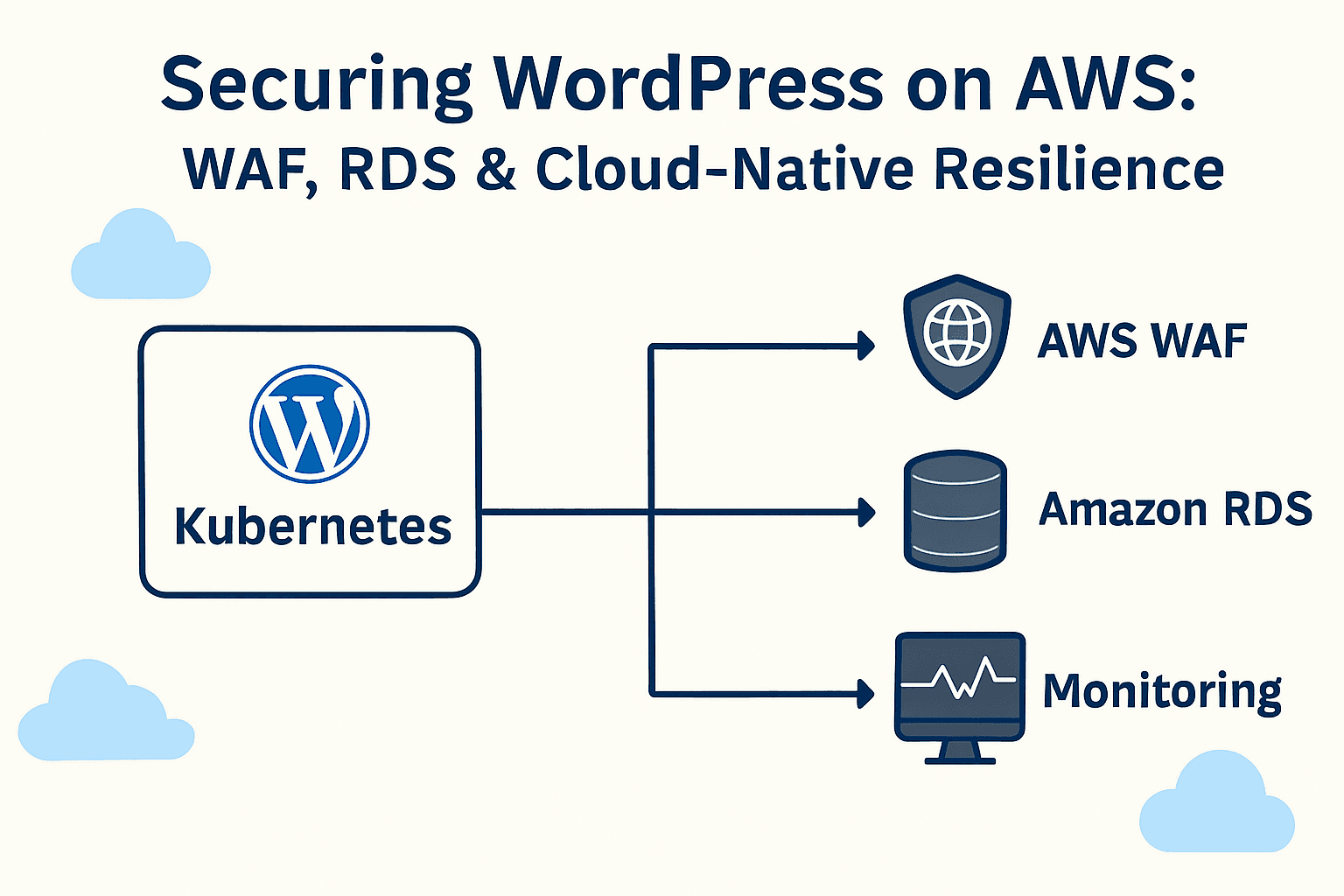Securing WordPress on AWS: WAF, RDS & Cloud-Native Resilience
Protect your WordPress with AWS WAF, RDS, and cloud-native resilience — stop attacks before they start and keep your data always backed up and available.

Nitin Garg
Founder, Zenthos
7 min read · Thu Jul 03 2025

In Part 1 of this series, we explored how Kubernetes, S3, and CloudFront can make WordPress scale faster and cost less.
But performance is only half the battle. What happens when your site faces a sudden DDoS attack, SQL injection attempt, or an unexpected database crash?
A modern WordPress setup isn’t complete without a security and resilience layer.
In this post, we’ll show how to protect and harden WordPress using AWS WAF, RDS, and continuous monitoring — ensuring your site stays online, backed up, and bulletproof.
1. The Evolving Threat Landscape
WordPress’s popularity makes it a magnet for attackers.
Every minute, bots attempt login brute-forces, comment spam, or plugin exploits.
While firewalls and captchas help, they can’t stop large-scale DDoS or zero-day exploits.
That’s where cloud-native defense comes in — scalable, adaptive, and managed at the infrastructure level.
2. Shield Your Application with AWS WAF
AWS Web Application Firewall (WAF) sits at the edge of your infrastructure — filtering malicious traffic before it ever reaches your cluster.
What it protects against
- Distributed Denial of Service (DDoS) attacks
- SQL injection and cross-site scripting (XSS)
- Brute-force login attempts
- Malicious bots and crawlers
How it integrates
- Attach WAF to your CloudFront distribution or Application Load Balancer.
- Use AWS Managed Rule Sets for instant protection.
- Add custom rules to block known attacker IPs or rate-limit requests.
With WAF and AWS Shield Standard, you get enterprise-grade protection with zero manual maintenance.
3. Protect the Heart: Amazon RDS for WordPress Databases
Your database is the lifeblood of WordPress — every post, comment, and configuration flows through it.
Running MySQL inside your Kubernetes cluster risks data loss if pods restart or nodes fail.
Amazon RDS (MySQL / PostgreSQL) eliminates that risk by offering:
- Automated backups & point-in-time restore
- Multi-AZ replication for high availability
- Read replicas to handle heavy traffic
- Encryption at rest and in transit
RDS handles updates, patching, and failovers automatically — letting you focus on content, not clusters.
4. Plan for the Worst: Disaster Recovery and Backups
Even the best setup needs an escape plan.
Design a backup and recovery workflow that covers:
- Daily automated RDS snapshots
- Versioned S3 buckets for media backups
- Replication of critical configuration files (wp-config.php, Helm charts)
- Regular restore tests to verify integrity
With this in place, your site can recover from data corruption or human error within minutes.
5. Watch Everything: Monitoring & Alerts
Security and performance go hand in hand.
Use AWS-native and open-source tools together:
- Amazon CloudWatch → metrics, alerts, and anomaly detection
- AWS GuardDuty → continuous threat intelligence and account-level monitoring
- Prometheus + Grafana → deep Kubernetes observability
- CloudTrail → audit trail for all AWS API actions
Set alerts for high error rates, CPU spikes, or unauthorized login attempts — prevention is cheaper than recovery.
6. Hardening the Stack
Small adjustments that make a big difference:
- Use IAM roles instead of static access keys.
- Enforce HTTPS via AWS Certificate Manager.
- Restrict security groups to required ports only.
- Implement least-privilege access for both humans and services.
- Rotate secrets automatically via AWS Secrets Manager.
This “defense-in-depth” approach ensures every layer — app, database, network, and identity — is locked down.
7. Bringing It All Together
A secure, resilient WordPress architecture on AWS looks like this:
- WordPress Pods (Kubernetes) — auto-scaling containers
- Amazon S3 + CloudFront — global static content delivery
- Amazon RDS — managed database with automatic backups
- AWS WAF + Shield — intelligent edge protection
- CloudWatch & GuardDuty — continuous monitoring and threat detection
Each piece complements the others — speed, stability, and safety working in unison.
8. The Business Case for Resilience
Beyond technical benefits, this setup offers tangible ROI:
- Reduced downtime costs: traffic surges or attacks no longer take you offline
- Regulatory compliance: built-in encryption and backup retention
- Lower maintenance overhead: AWS handles patching and security updates
- Customer trust: users experience reliability and confidence in your brand
Resilience isn’t an expense — it’s insurance for your digital presence.
Conclusion
In today’s internet, speed without security is fragile.
By layering AWS WAF, RDS, and intelligent monitoring over your Kubernetes + S3 foundation, your WordPress becomes not just fast — but unbreakable.
At Zenthos, we architect cloud-native WordPress environments that combine autoscaling, protection, and reliability — helping businesses scale confidently in the cloud.
Your site deserves to be fast, fearless, and future-ready.
